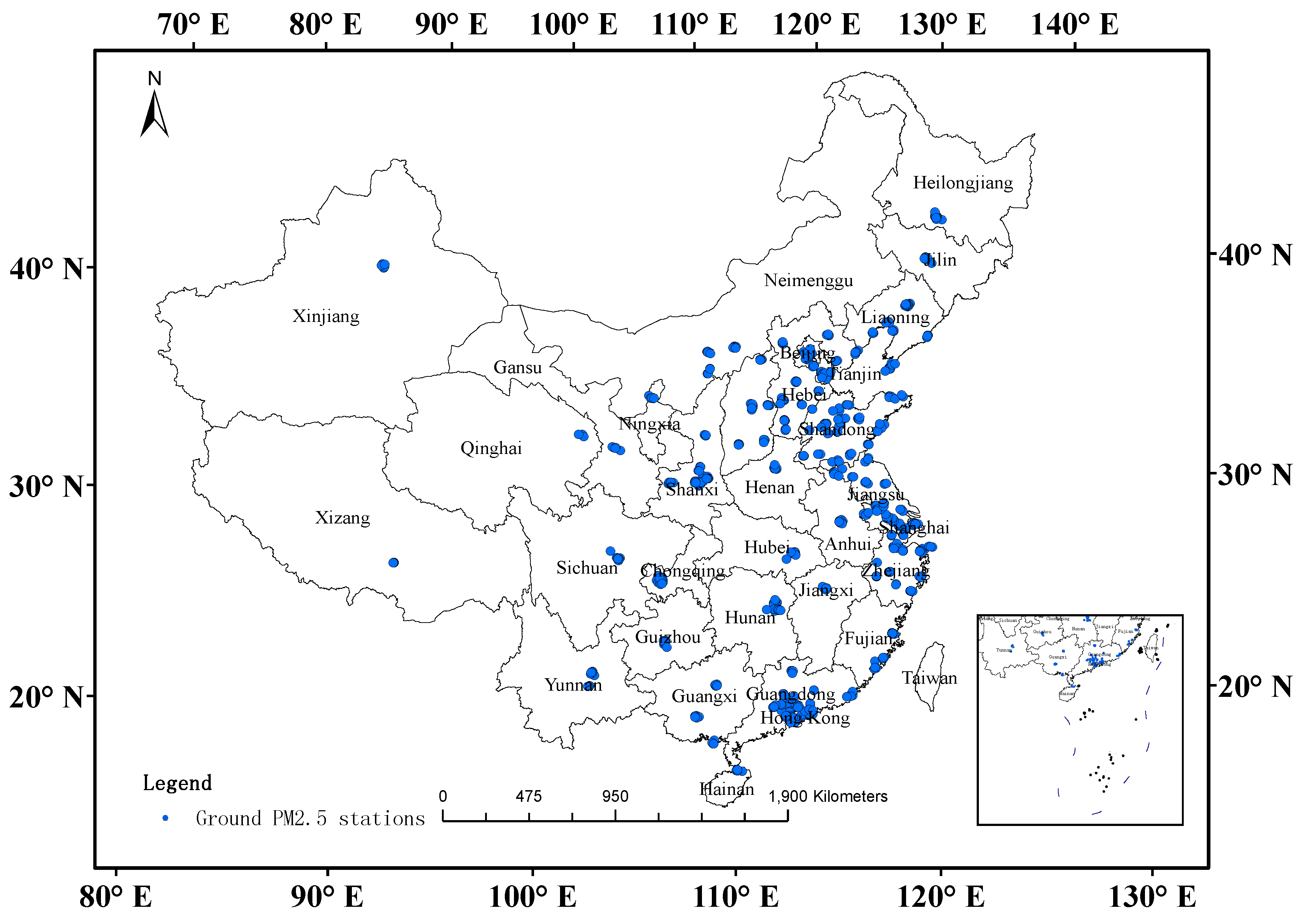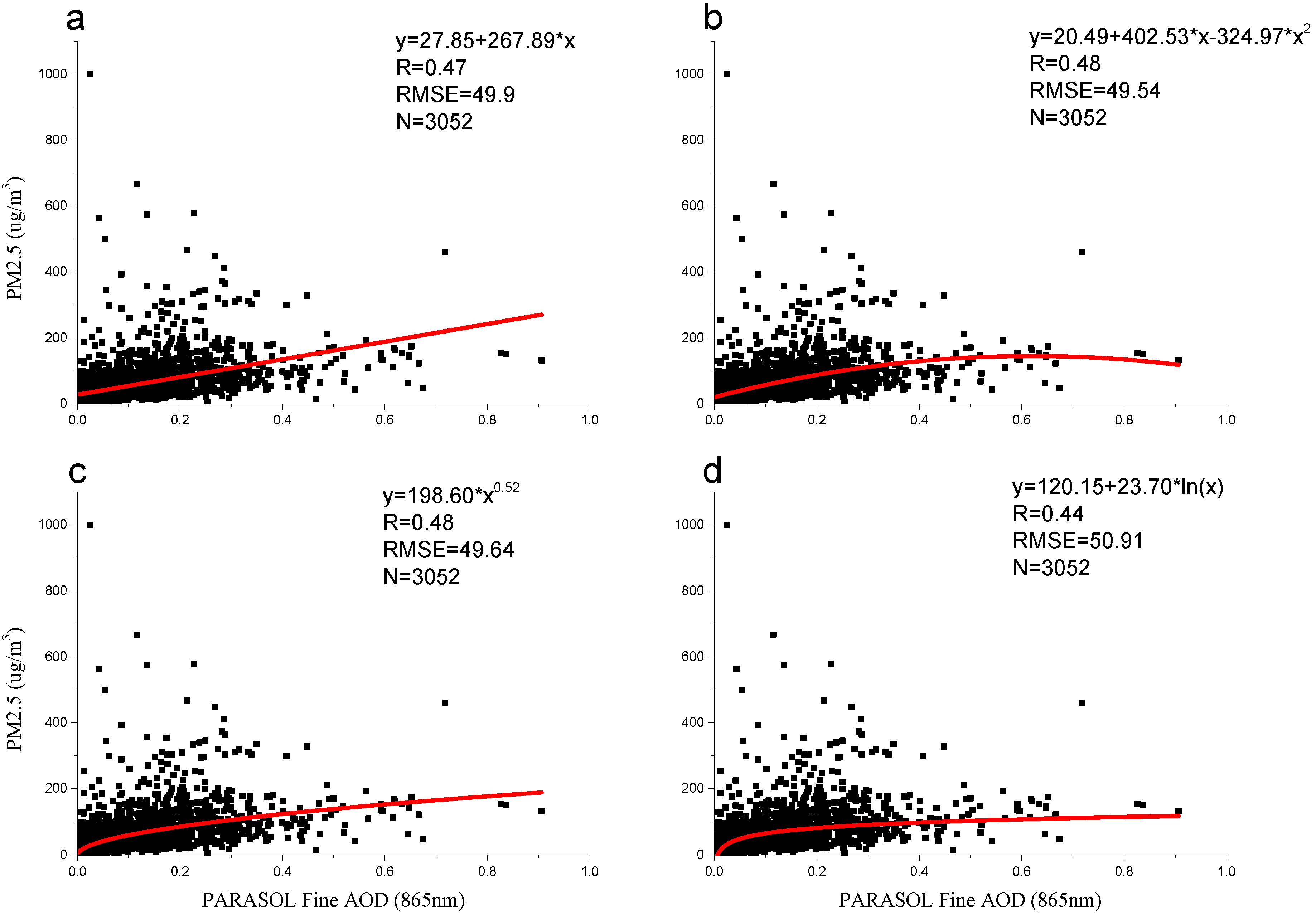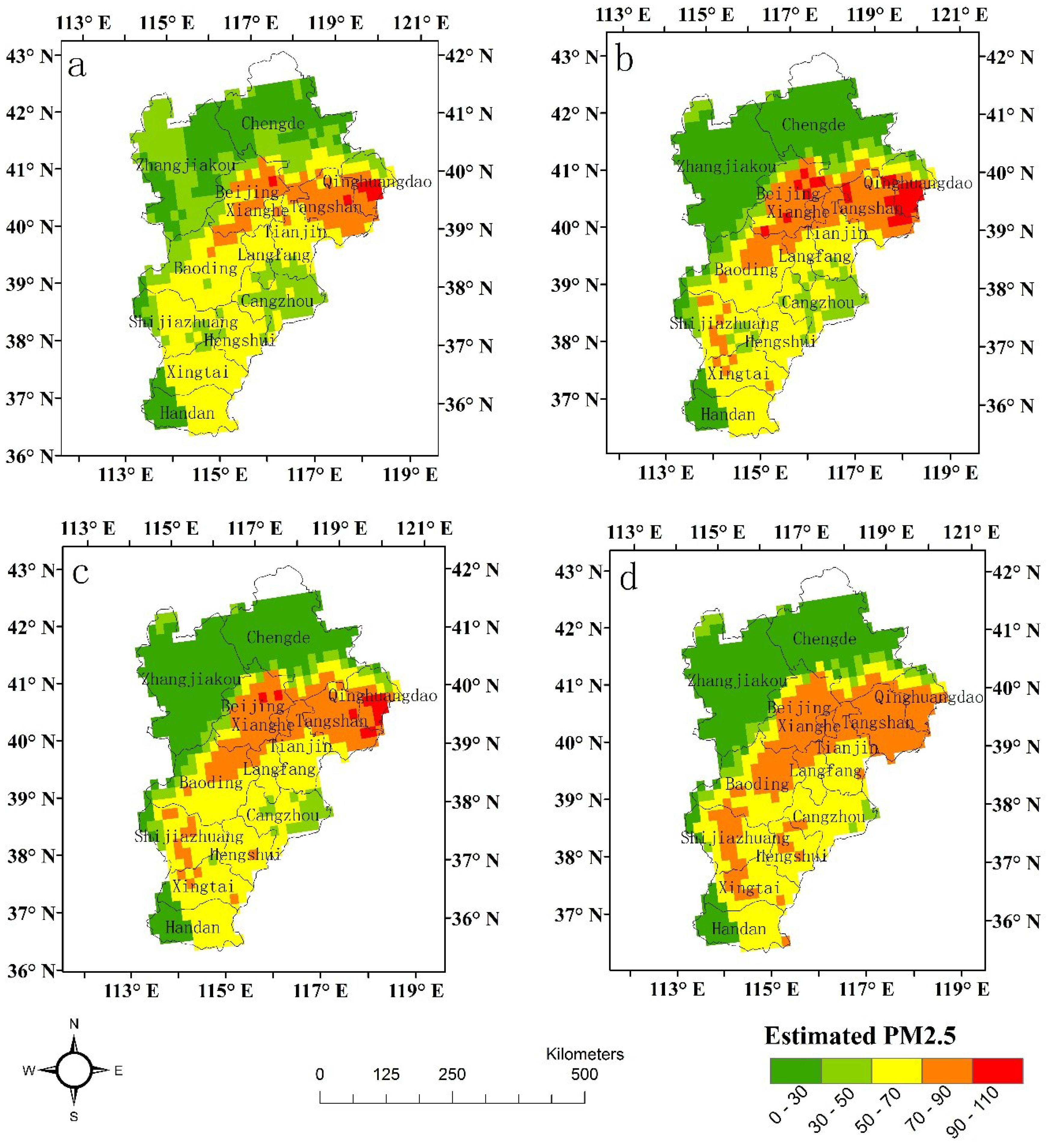Comparison of Four Ground-Level PM2.5 Estimation Models Using PARASOL Aerosol Optical Depth Data from China
Abstract
:1. Introduction
2. Materials and Methods
2.1. Parasol Aod
2.2. Ground-Level PM2.5 Concentrations

2.3. Data Processing
| Type | Parameter | N | Mean | Minimum | Maximum |
|---|---|---|---|---|---|
| Model Development | PM2.5 (μg/m3) | 3052 | 56.11 | 3 | 1000 |
| AOD | 3052 | 0.11 | 0.002 | 0.91 | |
| Model Validation | PM2.5 (μg/m3) | 1287 | 57.43 | 3 | 562 |
| AOD | 1287 | 0.12 | 0.002 | 0.59 |
2.4. Empirical Models
3. Results
3.1. Models Construction

3.2. The Spatial Distribution of PM2.5 Concentrations

3.3. Models Validation

3.4. Models’ Performance at Different PM2.5 Concentrations According to the AQI
| AQI | PM2.5 (μg/m3) | N | The Linear Model | The Quadratic Model | The Power Model | The Logarithmic Model | ||||
|---|---|---|---|---|---|---|---|---|---|---|
| R | p | R | p | R | p | R | p | |||
| 0–50 | 0–35 | 1777 | 0.37 | 0.0 | 0.43 | 0.0 | 0.44 | 0.0 | 0.44 | 0.0 |
| 51–100 | 35–75 | 1636 | 0.29 | 0.0 | 0.30 | 0.0 | 0.28 | 0.0 | 0.28 | 0.0 |
| 101–150 | 75–115 | 532 | 0.07 | 0.10 | 0.08 | 0.20 | 0.06 | 0.0 | 0.06 | 0.16 |
| 151–200 | 115–150 | 176 | 0.11 | 0.13 | 0.11 | 0.31 | 0.10 | 0.0 | 0.10 | 0.18 |
| 201–300 | 150–250 | 159 | 0.05 | 0.54 | 0.06 | 0.71 | 0.06 | 0.0 | 0.05 | 0.48 |
| >300 | >250 | 59 | 0.12 | 0.78 | 0.21 | 0.66 | 0.08 | 0.72 | 0.08 | 0.71 |
4. Discussion
5. Conclusions
Acknowledgments
Author Contributions
Conflicts of Interest
Abbreviations
| PM2.5 | Particles with an aerodynamic diameter ≤2.5 μm |
| MODIS | Moderate Resolution Imaging Spectroradiometer |
| MISR | Multi Angle Imaging Spectroradiometer |
| SeaWiFS | Sea viewing Wide Field of view Sensor |
| GEOS | Goddard Earth Observing System |
| PARASOL | Polarization & Anisotropy of Reflectances for Atmospheric Sciences coupled with Observations from a Lidar |
| POLDER | Polarization and Directionality of Earth’s Reflectances |
| AOD | Aerosol optical depth |
| R | correlation coefficient |
| AQI | Air Quality Index |
| CNEMC | China National Environmental Monitoring Center |
| IGBP | International Geosphere Biosphere Programme |
References
- An, X.; Hou, Q.; Li, N.; Zhai, S. Assessment of human exposure level to PM10 in China. Atmos. Environ. 2013, 70, 376–386. [Google Scholar] [CrossRef]
- Dockery, D.W.; Pope, C.A.; Xu, X.P.; Spengler, J.D.; Ware, J.H.; Fay, M.E.; Ferris, B.G.; Speizer, F.E. An association between air-pollution and mortality in 6 United-States cities. New Engl. J. Med. 1993, 24, 1753–1759. [Google Scholar] [CrossRef] [PubMed]
- Pope, C.A.; Burnett, R.T.; Thun, M.J.; Calle, E.E.; Krewski, D.; Ito, K.; Thurston, G.D. Lung cancer, cardiopulmonary mortality, and long-term exposure to fine particulate air pollution. JAMA-J. Am. Med. Assoc. 2002, 9, 1132–1141. [Google Scholar] [CrossRef]
- Hu, X.; Waller, L.; Al-Hamdan, M.; Crosson, W.L.; Estes, M.G., Jr.; Estes, A.M.; Quattrochi, D.A.; Sarnat, J.A.; Liu, Y. Estimating ground-level PM2.5 concentrations in the southeastern U.S. using geographically weighted regression. Environ. Res. 2013, 121, 1–10. [Google Scholar] [CrossRef] [PubMed]
- Ma, Z.; Hu, X.; Huang, L.; Bi, J.; Liu, Y. Estimating ground-level PM2.5 in China using satellite remote sensing. Environ. Sci. Technol. 2014, 48, 7436–7444. [Google Scholar] [CrossRef] [PubMed]
- Chudnovsky, A.A.; Koutrakis, P.; Kloog, I.; Melly, S.; Nordio, F.; Lyapustin, A.; Wang, Y.; Schwartz, J. Fine particulate matter predictions using high resolution Aerosol Optical Depth (AOD) retrievals. Atmos. Environ. 2014, 89, 189–198. [Google Scholar] [CrossRef]
- Wang, Z.; Liu, Y.; Hu, M.; Pan, X.; Shi, J.; Chen, F.; He, K.; Koutrakis, P.; Christiani, D.C. Acute health impacts of airborne particles estimated from satellite remote sensing. Environ. Int. 2013, 51, 150–159. [Google Scholar] [CrossRef] [PubMed]
- Koelemeijer, R.B.A.; Homan, C.D.; Matthijsen, J. Comparison of spatial and temporal variations of aerosol optical thickness and particulate matter over Europe. Atmos. Environ. 2006, 40, 5304–5315. [Google Scholar] [CrossRef]
- Kumar, N.; Chu, A.; Foster, A. Remote sensing of ambient particles in Delhi and its environs: estimation and validation. Int. J. Remote Sens. 2008, 29, 3383–3405. [Google Scholar] [CrossRef] [PubMed]
- Gupta, P.; Christopher, S.A.; Wang, J.; Gehrig, R.; Lee, Y.; Kumar, N. Satellite remote sensing of particulate matter and air quality assessment over global cities. Atmos. Environ. 2006, 40, 5880–5892. [Google Scholar] [CrossRef]
- Gupta, P.; Christopher, S.A.; Box, M.A.; Box, G.P. Multi year satellite remote sensing of particulate matter air quality over Sydney, Australia. Int. J. Remote Sens. 2007, 28, 4483–4498. [Google Scholar] [CrossRef]
- Gupta, P.; Christopher, S.A. Particulate matter air quality assessment using integrated surface, satellite, and meteorological products: 2. A neural network approach. J. Geophys. Res. 2009, 114. [Google Scholar] [CrossRef]
- Guo, J.P.; Zhang, X.Y.; Che, H.Z.; Gong, S.L.; An, X.; Cao, C.X.; Guang, J.; Zhang, H.; Wang, Y.-Q.; Zhang, X.-C.; et al. Correlation between PM concentrations and aerosol optical depth in eastern China. Atmos. Environ. 2009, 43, 5876–5886. [Google Scholar] [CrossRef]
- Liu, Y.; Paciorek, C.J.; Koutrakis, P. Estimating regional spatial and temporal variability of PM2.5 concentrations using satellite data, meteorology, and land use information. Environ. Health Perspect. 2009, 117, 886–892. [Google Scholar] [CrossRef] [PubMed]
- Liu, Y.; Wang, Z.; Wang, J.; Ferrare, R.A.; Newsom, R.K.; Welton, E.J. The effect of aerosol vertical profiles on satellite-estimated surface particle sulfate concentrations. Remote Sens. Environ. 2011, 115, 508–513. [Google Scholar] [CrossRef]
- Liu, Y.; He, K.; Li, S.; Wang, Z.; Christiani, D.C.; Koutrakis, P. A statistical model to evaluate the effectiveness of PM2.5 emissions control during the Beijing 2008 Olympic Games. Environ. Int. 2012, 44, 100–105. [Google Scholar] [CrossRef] [PubMed]
- Donkelaar, A.V.; Martin, R.V.; Brauer, M.; Kahn, R.; Levy, R.; Verduzco, C.; Villeneuve, P.J. Global estimates of ambient fine particulate matter concentrations from satellite-based aerosol optical depth: Development and application. Environ. Health Perspect. 2010, 118, 847–855. [Google Scholar] [CrossRef] [PubMed]
- Donkelaar, A.V.; Martin, R.V.; Levy, R.C.; da Silva, A.M.; Krzyzanowski, M.; Chubarova, N.E.; Semutnikova, E.; Cohen, A.J. Satellite-based estimates of ground-level fine particulate matter during extreme events: A case study of the Moscow fires in 2010. Atmos. Environ. 2011, 45, 6225–6232. [Google Scholar] [CrossRef]
- Donkelaar, A.V.; Martin, R.V.; Brauer, M.; Boys, B.L. Use of satellite observations for long-term exposure assessment of global concentrations of fine particulate matter. Environ. Health Perspect. 2015, 123, 135–143. [Google Scholar] [PubMed]
- Wang, Z.; Chen, L.; Tao, J.; Zhang, Y.; Su, L. Satellite-based estimation of regional particulate matter (PM) in Beijing using vertical-and-RH correcting method. Remote Sens. Environ. 2010, 114, 50–63. [Google Scholar] [CrossRef]
- Tian, J.; Chen, D. A semi-empirical model for predicting hourly ground-level fine particulate matter (PM2.5) concentration in southern Ontario from satellite remote sensing and ground-based meteorological measurements. Remote Sens. Environ. 2010, 114, 221–229. [Google Scholar] [CrossRef]
- Wang, C.; Liu, Q.; Ying, N.; Wang, X.; Ma, J. Air quality evaluation on an urban scale based on MODIS satellite images. Atmos. Res. 2013, 132–133, 22–34. [Google Scholar] [CrossRef]
- Saunders, R.O.; Kahl, J.; Ghorai, J. Improved estimation of PM2.5 using Lagrangian satellite-measured aerosol optical depth. Atmos. Environ. 2014, 91, 146–153. [Google Scholar] [CrossRef]
- Deuzé, J.L.; Bréon, F.M.; Devaux, C.; Goloub, P.; Herman, M.; Lafrance, B.; Maignan, F.; Marchand, A.; Nadal, F.; Perry, G.; et al. Remote sensing of aerosols over land surfaces from POLDER-ADEOS-1 polarized measurements. J. Geophys. Res. 2001, 106, 4913–4926. [Google Scholar] [CrossRef]
- Tanré, D.; Bréon, F.M.; Deuzé, J.L.; Dubovik, O.; Ducos, F.; François, P.; Goloub, P.; Herman, M.; Lifermann, A.; Waquet, F. Remote sensing of aerosols by using polarized, directional and spectral measurements within the A-Train: The PARASOL mission. Atmos. Meas. Tech. 2011, 4, 1383–1395. [Google Scholar] [CrossRef]
- Dubovik, O.; Herman, M.; Holdak, A.; Lapyonok, T.; Tanré, D.; Deuzé, J.L.; Ducos, F.; Sinyuk, A.; Lopatin, A. Statistically optimized inversion algorithm for enhanced retrieval of aerosol properties from spectral multi-angle polarimetric satellite observations. Atmos. Meas. Tech. 2011, 4, 975–1018. [Google Scholar] [CrossRef] [Green Version]
- Cheng, T.H.; Gu, X.F.; Yu, T.; Tian, G.L. The reflection and polarization properties of non-spherical aerosol particles. J. Quant. Spectrosc. Radiat. Transfer. 2010, 111, 895–906. [Google Scholar] [CrossRef]
- Cheng, T.H.; Gu, X.F.; Xie, D.H.; Li, Z.Q.; Yu, T.; Chen, X.F. Simultaneous retrieval of aerosol optical properties over the Pearl River Delta, China using multi-angular, multi-spectral, and polarized measurements. Remote Sens. Environ. 2011, 115, 1643–1652. [Google Scholar] [CrossRef]
- Cheng, T.; Gu, X.; Xie, D.; Li, Z.; Yu, T.; Chen, H. Aerosol optical depth and fine-mode fraction retrieval over East Asia using multi-angular total and polarized remote sensing. Atmos. Meas. Tech. 2012, 5, 501–516. [Google Scholar] [CrossRef]
- Gu, X.; Cheng, T.; Xie, D.; Li, Z.; Yu, T.; Chen, H. Analysis of surface and aerosol polarized reflectance for aerosol retrievals from polarized remote sensing in PRD urban region. Atmos. Environ. 2011, 45, 6607–6612. [Google Scholar] [CrossRef]
- Guo, H.; Gu, X.; Xie, D.; Yu, T.; Meng, Q. A review of atmospheric aerosol research by using polarization remote sensing. Spectrosc. Spectral Anal. 2014, 34, 1873–1880. [Google Scholar]
- Kacenelenbogen, M.; Léon, J.-F.; Chiapello, I.; Tanré, D. Characterization of aerosol pollution events in France using ground-based and POLDER-2 satellite data. Atmos. Chem. Phys. 2006, 6, 4843–4849. [Google Scholar] [CrossRef]
- National Urban Air Quality in Real-Time Publishing Platform. Available online: http://113.108.142.147:20035/emcpublish/ (accessed on 9 December 2015).
- Cloud-Aerosol-Water-Radiation Interactions. Available online: http://www.icare.univ-lille1.fr/ (accessed on 9 December 2015).
- Deschamps, P.-Y.; Bréon, F.-M.; Leroy, M.; Podaire, A.; Bricaud, A.; Buriez, J.-C.; Sèze, G. The POLDER mission instrument chamcteristics and scientific objectives. IEEE Trans. Geosci. Remote Sens. 1994, 32, 598–615. [Google Scholar] [CrossRef]
- Tanré, D.; Bréon, F.M.; Deuzé, J.L.; Herman, M.; Goloub, P.; Nadal, F.; Marchand, A. Global observation of anthropogenic aerosols from satellite. Geophys. Res. Lett. 2001, 28, 4555–4558. [Google Scholar] [CrossRef]
- Bréon, F.M.; Vermeulen, A.; Descloitres, J. An evaluation of satellite aerosol products against sunphotometer measurements. Remote Sens. Environ. 2011, 115, 3102–3111. [Google Scholar] [CrossRef]
- Nadal, F.; Bréon, F.M. Parameterization of surface polarized reflectance derived from POLDER spaceborne measurements. IEEE Trans. Geosci. Remote Sens. 1999, 37, 1709–1718. [Google Scholar] [CrossRef]
- Dubovik, O.; Holben, B.N.; Eck, T.F.; Smirnov, A.; Kaufman, Y.J.; King, M.D.; Tanré, D.; Slutsker, I. Variability of absorption and optical properties of key aerosol types observed in worldwide locations. J. Atmos. Sci. 2002, 59, 590–608. [Google Scholar] [CrossRef]
- Duan, M.; Qilong, M.; Stamnes, K. Impact of vertical stratification of inherent optical properties on radiative transfer in a plane-parallel turbid medium. Opt. Express 2010, 18, 5629–5638. [Google Scholar] [CrossRef] [PubMed]
- Duan, M.; Qilong, M.; Daren, L. A polarized Radiative Transfer model based on successive order of scattering. Adv. Atmos. Sci. 2010, 27, 891–900. [Google Scholar] [CrossRef]
- Xie, D.; Cheng, T.; Zhang, W.; Yu, J.; Li, X.; Gong, H. Aerosol type over east Asian retrieval using total and polarized remote Sensing. J. Quant. Spectrosc. Radiat. Transfer. 2013, 129, 13–15. [Google Scholar] [CrossRef]
- Fan, X.; Goloub, P.; Deuzé, J.-L.; Chen, H.; Zhang, W.; Tanré, D.; Li, Z. Evaluation of PARASOL aerosol retrieval over North East Asia. Remote Sens. Environ. 2008, 112, 697–707. [Google Scholar] [CrossRef]
- Su, X.; Goloub, P.; Chiapello, I.; Chen, H.; Ducos, F.; Li, Z. Aerosol variability over East Asia as seen by POLDER space-borne sensors. J. Geophys. Res. 2010, 115, D24215. [Google Scholar] [CrossRef]
- Li, C.; Hsu, N.C.; Tsay, S. A study on the potential applications of satellite data in air quality monitoring and forecasting. Atmos. Environ. 2011, 45, 3663–3675. [Google Scholar] [CrossRef]
- Zheng, J.; Che, W.; Zheng, Z.; Chen, L.; Zhong, L. Analysis of spatial and temporal variability of PM10 concentrations using MODIS aerosol optical thickness in the Pearl River Delta Region, China. Aerosol. Air Qual. Res. 2013, 13, 862–876. [Google Scholar] [CrossRef]
- Hu, X.; Waller, L.; Lyapustin, A.; Wang, Y.; Al-Hamdan, M.Z.; Crosson, W.; Estes, M.; Estes, S.; Quattrochi, D.; Puttaswamy, S.; et al. Estimating ground-level PM2.5 concentrations in the Southeastern United States using MAIAC AOD retrievals and a two-stage model. Remote Sens. Environ. 2014, 140, 220–232. [Google Scholar] [CrossRef]
- Benas, N.; Beloconi, A.; Chrysoulakis, N. Estimation of urban PM10 concentration, based on MODIS and MERIS/AATSR synergistic observations. Atmos. Environ. 2013, 79, 448–454. [Google Scholar] [CrossRef]
- Lee, H.J.; Liu, Y.; Coull, B.A.; Schwartz, J.; Koutrakis, P. A novel calibration approach of MODIS AOD data to predict PM2.5 concentrations. Atmos. Chem. Phys. 2011, 11, 7991–8002. [Google Scholar] [CrossRef]
- Lee, H.J.; Coull, B.A.; Bell, M.L.; Koutrakis, P. Use of satellite-based aerosol optical depth and spatial clustering to predict ambient PM2.5 concentrations. Environ. Res. 2012, 118, 8–15. [Google Scholar] [CrossRef] [PubMed]
- Liu, Y.; Park, R.J.; Jacob, D.J.; Li, Q.B.; Kilaru, V.; Sarnat, J.A. Mapping annual mean ground-level PM2.5 concentrations using Multiangle Imaging Spectroradiometer aerosol optical thickness over the contiguous United States. J. Geophys. Res.-Atmos. 2004, 109. [Google Scholar] [CrossRef]
- Yap, X.Q.; Hashim, M. A robust calibration approach for PM10 prediction from MODIS aerosol optical depth depth. Atmos. Chem. Phys. 2013, 13, 3517–3526. [Google Scholar] [CrossRef]
© 2016 by the authors; licensee MDPI, Basel, Switzerland. This article is an open access article distributed under the terms and conditions of the Creative Commons by Attribution (CC-BY) license (http://creativecommons.org/licenses/by/4.0/).
Share and Cite
Guo, H.; Cheng, T.; Gu, X.; Chen, H.; Wang, Y.; Zheng, F.; Xiang, K. Comparison of Four Ground-Level PM2.5 Estimation Models Using PARASOL Aerosol Optical Depth Data from China. Int. J. Environ. Res. Public Health 2016, 13, 180. https://doi.org/10.3390/ijerph13020180
Guo H, Cheng T, Gu X, Chen H, Wang Y, Zheng F, Xiang K. Comparison of Four Ground-Level PM2.5 Estimation Models Using PARASOL Aerosol Optical Depth Data from China. International Journal of Environmental Research and Public Health. 2016; 13(2):180. https://doi.org/10.3390/ijerph13020180
Chicago/Turabian StyleGuo, Hong, Tianhai Cheng, Xingfa Gu, Hao Chen, Ying Wang, Fengjie Zheng, and Kunshen Xiang. 2016. "Comparison of Four Ground-Level PM2.5 Estimation Models Using PARASOL Aerosol Optical Depth Data from China" International Journal of Environmental Research and Public Health 13, no. 2: 180. https://doi.org/10.3390/ijerph13020180






